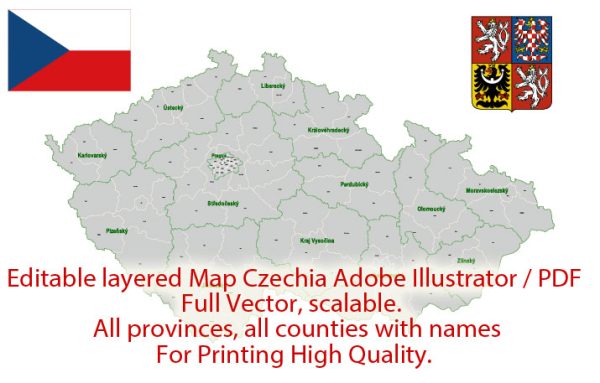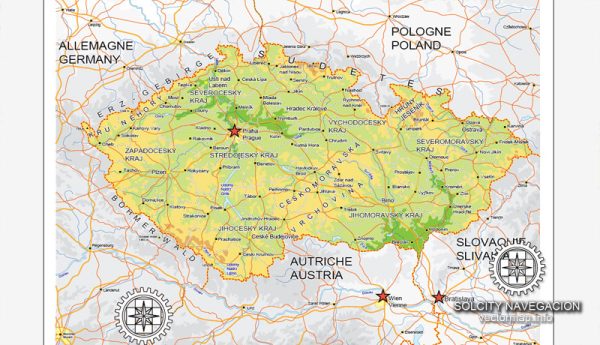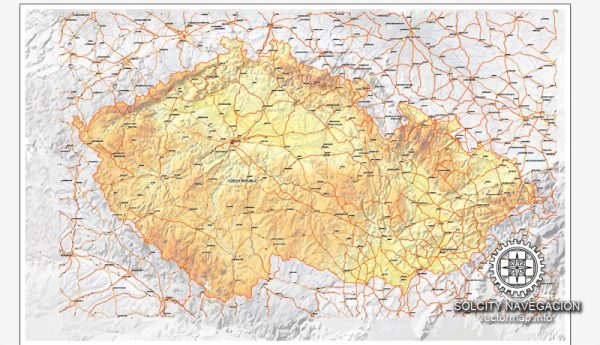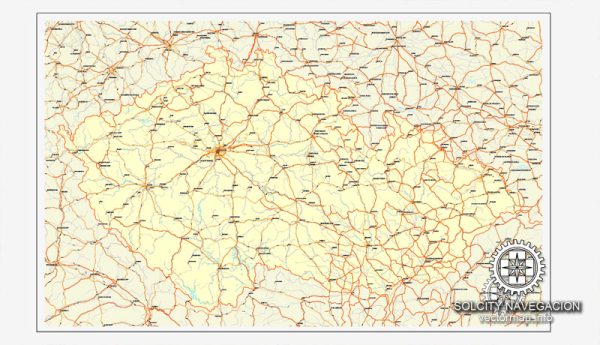An overview of the political and transportation history of the Czech Republic.
Vectormap.Net provide you with the most accurate and up-to-date vector maps in Adobe Illustrator, PDF and other formats, designed for editing and printing. Please read the vector map descriptions carefully.
Political History:
- Early History: The Czech lands have a rich history, with the earliest known inhabitants dating back to the Paleolithic era. Slavic tribes settled in the region during the 6th century.
- Great Moravian Empire: In the 9th century, the Great Moravian Empire emerged, incorporating parts of present-day Czech Republic. It played a crucial role in the spread of Christianity in the region.
- Formation of Czech Statehood: The Duchy of Bohemia was established in the 9th century, eventually becoming the Kingdom of Bohemia in 1198 under the rule of King Ottokar I.
- Habsburg Rule: The Habsburg monarchy gained control over Bohemia in the 16th century, leading to the Czech lands becoming an integral part of the Austro-Hungarian Empire.
- First Czechoslovak Republic: After World War I, Czechoslovakia was formed in 1918, including Czech and Slovak territories. Tomas Masaryk became the first president.
- World War II and Communist Era: Nazi Germany occupied Czechoslovakia during World War II. After the war, the country came under Soviet influence, leading to the establishment of a communist regime in 1948. The Prague Spring in 1968, an attempt at political liberalization, was crushed by Soviet intervention.
- Velvet Revolution: The fall of communism came in 1989 with the Velvet Revolution, a peaceful protest led by Vaclav Havel. Czechoslovakia transitioned to democracy, and Havel became its first post-communist president.
- Czech Republic’s Independence: In 1993, Czechoslovakia peacefully split into two separate countries, the Czech Republic and Slovakia, leading to the establishment of the current political structure.
- European Union and NATO: The Czech Republic joined the European Union in 2004 and NATO in 1999, solidifying its place in the European political landscape.
Transportation History:
- Historical Roads and Trade Routes: The Czech lands have been a crossroads for trade routes since medieval times. Roads such as the Amber Road and the Royal Route played significant roles in connecting the region to other parts of Europe.
- Railways: The development of railways in the 19th century, during the Austro-Hungarian Empire, greatly improved transportation. The first railway in the Czech lands connected Vienna and Brno in 1837.
- Automobiles: The Czech Republic has a strong automotive history. Companies like Skoda, founded in 1895, played a crucial role in the development of the automobile industry. Skoda continues to be a major player in the global automotive market.
- Public Transportation: Prague has an extensive public transportation system, including buses, trams, and a metro system. It is known for its efficiency and connectivity.
- Air Transportation: Prague’s Vaclav Havel Airport is the main international gateway. It has undergone significant expansion and modernization to accommodate the growing air traffic.
- Infrastructure Development: The Czech Republic has continually invested in modernizing its transportation infrastructure, including highways and high-speed rail connections, to enhance connectivity within the country and across Europe.
This overview provides a snapshot of the political and transportation history of the Czech Republic, but the actual history is rich and complex, shaped by numerous events and influences over the centuries.






 Author: Kirill Shrayber, Ph.D.
Author: Kirill Shrayber, Ph.D.